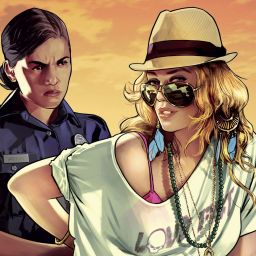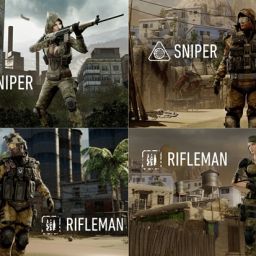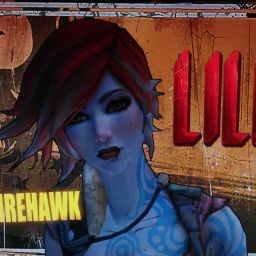by Kristin Bezio
The recent debacle about Bioshock Infinite’s cover art – and what appears to be a response-in-act-if-not-words from Naughty Dog – has raised awareness not only about what we see and expect to find on the box art of videogames, but what the fans really want… as opposed to what the publishers and developers think their fans want to see on the box.
What happened with Infinite is that in a game that is all about “rescuing” a woman named Elizabeth (who is powerful and helpful to you as the player in her own right), Elizabeth is not on the cover.
Booker DeWitt (the player character) is, as he probably should be, but Elizabeth doesn’t even feature in the background, the way that female companion characters often do… as in Ico or Mass Effect 1 and 2, or Resident Evil 5. This caused a bit of a fan outcry, since it seemed not only irresponsible, but sexist to exclude the one character the game has been promoting (and featuring in their trailers) from the beginning. The excuse offered by Ken Levine (Irrational’s artistic director) was that Booker on his own would be more appealing to their target audience, because no one buys videogames with women on the covers.
I found twenty-seven covers, nine of them exclusively with women on them, that would argue against that point. But I’m not ready to go there just yet, because the Infinite cover art saga continues. The fan upset caused Irrational to run a contest for “reversible box art” so that the fans who were upset at the absence of Elizabeth on the cover could be appeased. The cover the fans chose admittedly doesn’t have Elizabeth on it, either, but neither does it have Booker – instead, it has a stylized illustration of the city of Columbia and the game’s main “monster,” Songbird.
Now this tells me a couple of things. First, that the fans have good taste in art – they don’t want a run-of-the-mill “movie poster” style cover that features the “hero.” They want something interesting. Something with artistic merit. And not necessarily their male fantasy hero, either. And this echoes an earlier debate in 2001 concerning Ico’s cover: the game’s release was apparently surrounded by complaints about their American version (featuring Ico front and center with a ghostly image of Yorda’s face in the background). The preferred (European/Japanese) box art seems to be an abstract painting with two figures (Ico and Yorda, presumably) running through a bleak and bizarre landscape. For my purposes, both versions have the same people, but the debate (briefly mentioned in a Kotaku article) does relate to what I’m looking at in terms of box art and the “perceived audience” for that art.
In short, fans seem to prefer art in their box art, which gives me hope for the preferences and open-mindedness of the gaming community. Top that off with the fact that developer Naughty Dog refused to take their publisher’s advice about removing Ellie from the cover art of their upcoming (2013) The Last of Us, which features both Ellie (foreground) and Joel (background), and it seems to me that the prevailing belief about what fans want in their box art seems to be a little off.
All this made me wonder just how many boxes really do feature solo male protagonists, so I started doing a little research.
Here goes.
I looked at the box art for 111 games (not an intentional number, just what I ended up with) from 1979-2013. I used a list found on Wikipedia, which may or may not be the best thing to use, but it’s one of the easiest, so it’s the one that I settled on and then added some recent popular games to it. Among the top-selling videogames, there is a clear box-art preference for men as the featured cover-star over women. However, I’m not convinced that these statistics justify the argument that men-only covers sell games better than mixed covers, or covers with women… or beasties, or space ships, or abstract art designs.
That said, I found no box art in which the female on the cover was cowering behind a male counterpart a la 1970s pulp science fiction novel covers or movie posters, so that’s a definite kudos to the videogame box art industry. Women who appeared on mixed-gender box art were often armed or otherwise clear participants (in a positive way) in the game, as in Resident Evil 5 (where Sheva Alomar stands back-to-back with Chris Redfield, who admittedly occupies more of the cover-space) or Mass Effect 2 (Miranda Lawson and the alien Thane Krios are both armed behind a male Shepard). However, there were several major titles which did have stand-alone women on the covers: The Tomb Raider series (Eidos) highlights Lara Croft alone, the Metroid series (Nintendo) has Samus Aran, Heavenly Sword (Sony, 2007) has Nariko, Final Fantasy XIII (Square Enix, 2010) has Lightning, Assassin’s Creed: Liberation (Capcom, 2012) has Aveline, and Bayonetta (Platinum/Sega, 2010) of course features Bayonetta. All in all, of the twenty-seven boxes I found with women, nine had solo female heroes; two were “alternate covers” for Dead or Alive 3 (Tecmo, 2001) featuring solo women (the third cover features a solo male); and sixteen had women along with men (although two of those were Grand Theft Auto covers, and the women were undoubtedly prostitutes).
In none of them were the women playing obvious victims, and in light of the misogyny that we keep seeing in the gaming community, I view that as a positive thing and as an indication that while games could treat their women better, they’re not setting out to objectify and victimize them to an excessive degree (even if the games inside the boxes are less successful than their exterior packaging at doing so).
However, I do have to acknowledge that of the 111 covers, seventy-two had men on them. Of those seventy-two, thirty-nine were solo male hero figures. Seven had multiple men, but only men, and twenty-four featured some sort of mix between men and women, men and machines, and men and monsters. One cover was a male villain (the Mad Bomber from Activision’s 1981 Kaboom!). I didn’t count non-humans (sort of… Pac Man, while being a circle, is an approximation of a human and is called a “Man” so I counted him as a male protagonist) as male or female, but I found ten covers containing non-human antagonists, including five covers featuring only the antagonists. I also found eight that featured a non-human hero, like E.T. (Atari, 1982), which showed both Elliot and E.T., or Star Fox (Nintendo, 1993), which had Star Fox alone. Interestingly, all the non-human heroes on the covers were technically designated male, so I suppose that does make for four additional male heroes (since four were already mixed with humans). The non-human villains were more evenly split: the queen of the Zerg (Blizzard’s 1998 Starcraft) is female, although Diablo (Blizzard’s Diablo series) and Nemesis (Capcom’s 1999 Resident Evil 3) are clearly male.
I also found covers without anything discernibly gendered whatsoever. First, those featuring machines: space ships, cars, turrets, helicopters, airplanes, ships, etc., of which there were eleven machine-only covers and two men-and-machine covers. I consider it a positive that more titles possessing women on their covers seem to have been popular than titles with only machines, although there are fewer solo-women covers than machines on the list. Finally, covers that were stylized and artistic, without people or – sometimes – anything recognizably anything. Of these ten, some are hugely popular: Bethesda’s Elder Scrolls series (2002 Morrowind and 2012 Skyrim); Nintendo’s Legend of Zelda series titles The Legend of Zelda (1986), Zelda 2 (1988), and Ocarina of Time (1998); Insomniac’s Resistance (2006); Quantum Dream’s Heavy Rain (2010); Bioware’s Dragon Age: Origins (2009) and Dragon Age: Awakening (2010); and Capcom’s Resident Evil 2 (1998) and Resident Evil 6 (2012).
Between the success of the more recent abstract-cover titles – like Dragon Age, the Zelda series (which is enormously popular and always has been), Heavy Rain, and Skyrim – and the debates over the covers of Ico and Infinite, it seems to me that what fans want in their box art is actually unrelated to gender and has a lot more to do with how “pretty” the art is. In essence, is it art? Sure, millions of gamers are going to buy Call of Duty, but they’re not buying it because it has a male soldier on the cover. They’re buying it because of the type of gameplay it has, and they would buy just as many copies if the cover art featured a gun or a grenade.
The problem we’re seeing with the Infinite debacle is that publishers and developers (or just publishers, in the case of Naughty Dog) are mistaking correlation for causation. Good games, games with good mechanics and good stories, will sell whether the cover features a man, a woman, or – as we’ve seen – a giant red dragon. And while it is true that, proverb aside, we do judge our games (and books) by their covers, a quality cover with actual artistic merit is ultimately going to prove more effective in getting someone to pick it up and read the back than endless iterations of male soldiers carrying guns.
Appendix
MALE HEROES (39 solo, 7 men only, 1 alternate cover, 24 mixed categories) [71 total]
Pac Man (Namco, 1982) – Pac Man
Pitfall! (Activision, 1982) – Harry
Missile Command (Atari, 1980) – misc. soldier
E.T. (Atari, 1982) – Elliot
Adventure (Atari, 1979) – A small mounted knight
Space Battle (Intellivision, 1979) – Space pilots/controllers
Halo (Bungie, 2001) – Master Chief & male soldier
Halo 2 (Bungie, 2004) – Master Chief
Splinter Cell (Ubisoft, 2002) – Fisher
Fable (Lionhead, 2004) – The Hero*
Knights of the Old Republic (Bioware, 2003) – Revan*
Counter-Strike (Valve, 2004) – Male soldiers (2)
GTA: San Andreas (Rockstar, 2004) – CJ (along with two other men, some male gangsters in a car, and a woman, identities uncertain, although the men appear to be Frank and Jethro, and the woman an unnamed prostitute)
Madden NFL 2005 (EA, 2005) – Ray Lewis
Madden NFL 06 (EA, 2006) – Donovan McNabb
Call of Duty 2 (Treyarch, 2005) – Male soldier (with other male soldiers)
ESPN NFL 2K5 (2K Sports, 2004) – Terrell Owens
Dead or Alive 3 (Tecmo, 2001) – Jann Lee^
Star Wars: Battlefront (Pandemic, 2004) – Stormtrooper
Star Wars: Battlefront II (Pandemic, 2005) – Stormtrooper, Jedi, Vader
Ghost Recon (Red Storm, 2001) – Two male soldiers
Call of Duty: Black Ops (Treyarch, 2010) – Alex Mason
Modern Warfare 3 (Infinity Ward, 2011) – John McTavish
Modern Warfare 2 (Infinity Ward, 2009) – Gary Sanderson
Halo 3 (Bungie, 2007) – Master Chief
Gears of War (Epic, 2006) – Marcus Fenix, Dom Santiago, Anthony Carmine
Gears of War 2 (Epic, 2008) – Marcus Fenix, Dom Santiago
GTA IV (Rockstar, 2008) – Niko Bellic, Little Jocob (three other men, one woman with lollipop)
Call of Duty 4: Modern Warfare (Infinity Ward, 2007) – Male soldier
Fable II (Lionhead, 2009) – Hero*
Call of Duty: World at War (Treyarch, 2008) – Male soldier
Halo Reach (Bungie, 2010) – Carter, Jorge, Jun
Gears of War 3 (Epic, 2011) – Marcus Fenix, Dom Santiago, Augustus Cole
Halo: ODST (Bungie, 2009) – Rookie
Super Mario Brothers (Nintendo, 1985) – Mario
Super Mario Brothers 3 (Nintendo, 1990) – Mario
Super Mario Brothers 2 (Nintendo, 1988) – Mario
Teenage Mutant Ninja Turtles (Ultra, 1989) – Leonardo, Donatello, Michelangelo, Raphael
Dragon Quest IV (Square Enix, 1992) – Solo/Sofia,*Borya, Torneko, Ragnar
Dragon Warrior II (Square Enix, 1987) – Prince of Midenhall, Prince of Cannock
Super Mario World (Nintendo, 1990) – Mario
Super Mario Galaxy (Nintendo, 2007) – Mario
Zelda: Twilight Princess (Nintendo, 2006) – Link
Final Fantasy VII (Square Enix, 1997) – Cloud Strife
Final Fantasy VIII (Square Enix, 1999) – Squall Lionheart, Zell Dincht
Metal Gear Solid (Konami, 1998) – Solid Snake
God of War III (Sony, 2010) – Kratos
Uncharted 3 (Naughty Dog, 2009) – Nathan Drake
Uncharted 2 (Naughty Dog, 2009) – Nathan Drake
Metal Gear Solid 4 (Kojima, 2008) – Solid Snake
Uncharted: Drake’s Fortune (Naughty Dog, 2007) – Nathan Drake
inFamous (Sucker Punch, 2009) – Cole McGrath
Resident Evil 5 (Capcom, 2009) – Chris Redfield
Red Dead Redemption (Rockstar, 2010) – John Marston
Half-Life 2 (Valve, 2004) – Gordon Freeman
Battlefield 2 (DICE, 2009) – Male soldier
Mass Effect (Bioware, 2007) – Shepard*
Mass Effect 2 (Bioware, 2009) – Shepard*
Mass Effect 3 (Bioware, 2012) – Shepard*
Dragon Age II (Bioware, 2011) – Hawke*
Assassin’s Creed (Ubisoft, 2007) – Desmond Miles/Altair
Assassin’s Creed II (Ubisoft, 2009) – Desmond Miles/Ezio
Assassin’s Creed III (Ubisoft, 2012) – Desmond Miles/Connor/Ratonhnhaké:ton
Dishonored (Bethesda, 2012) – Corvo Attano
Resident Evil (Capcom, 1996) – Chris Redfield* (can play as Jill Valentine)
Resident Evil 4 (Capcom, 2005) – Leon Kennedy
Bioshock (Irrational/2K, 2007) – Big Daddy
Bioshock 2 (2K Marin, 2010) – Big Daddy
Bioshock Infinite (Irrational, 2013) – Booker DeWitt
The Last of Us (Naughty Dog, 2013) – Joel
Shadow of the Colossus (Sony, 2005) – Wander
Ico (Sony, 2001) – Ico
FEMALE HEROES (9 solo, 2 alternate covers, 16 mixed) [27 total)
Knights of the Old Republic (Bioware, 2003) – The Exile*
Dead or Alive 3 (Tecmo, 2001) – Christie^
Dead or Alive 3 (Tecmo, 2001) – Ayane^
Halo Reach (Bungie, 2010) – Emile, Kat
Gears of War 3 (Epic, 2011) – Anya Stroud
Dragon Quest IV (Square Enix, 1992) – Alena
Metroid (Nintendo, 1987) – Samus Aran
Dragon Warrior II (Square Enix, 1987) – Princess of Moonbrooke
Metroid Prime (Nintendo, 2002) – Samus Aran
Metroid Prime 3: Corruption (Nintendo, 2007) – Samus Aran
Final Fantasy VIII (Square Enix, 1999) – Rinoa Heartilly
Tomb Raider II (Eidos, 1997) – Lara Croft
Tomb Raider (Eidos, 1996) – Lara Croft
Final Fantasy XIII (Square Enix, 2010) – Lightning
Resident Evil 5 (Capcom, 2009) – Sheva Alomar
Heavenly Sword (Sony, 2007) – Nariko
Mass Effect (Bioware, 2007) – Ashley Williams
Mass Effect 2 (Bioware, 2009) – Miranda Lawson
Mass Effect 3 (Bioware, 2012) BACK of collector’s edition – Shepard*
Assassin’s Creed: Liberation (DLC – Playstation Vita only, Ubisoft, 2012) – Aveline
Bayonetta (Platinum/Sega, 2010) – Bayonetta
Bioshock (Irrational/2K, 2007) – Little Sister
Bioshock 2 (2K Marin, 2010) – Little Sister
The Last of Us (Naughty Dog, 2013) – Ellie
Ico (Sony, 2001) – Yorda
GTA IV (Rockstar, 2008) – one woman with lollipop
GTA: San Andreas (Rockstar, 2004) – an unnamed prostitute
MALE VILLAINS (1 solo)
Kaboom! (Activision, 1981) – The Mad Bomber
NON-HUMAN MONSTERS (5 solo, 5 mixed)
Pac Man (Namco, 1982) – Ghosts
Pitfall! (Activision, 1982) – scorpion & alligators
Space Invaders (Taito, 1978) – Weird alien things
n Attack (Imagic, 1982) – What appear to be silver space dinosaurs
Adventure (Atari, 1979) – Rhindle (red dragon)
Dragon Warrior III (Square Enix, 1991) – gold dragon
Dragon Warrior II (Square Enix, 1987) – green dragon
StarCraft (Blizzard, 1998) – Zerg
Diablo III (Blizzard, 2012) – Diablo
Resident Evil 3 (Capcom, 1999) – Nemesis (zombie)
Resident Evil 4 (Capcom, 2005) – Zombies
Shadow of the Colossus (Sony, 2005) – Colossus
NON-HUMAN ALLIES/HEROES (4 solo, 4 mixed)
E.T. (Atari, 1982) – E.T.
Donkey Kong (Nintendo, 1981) – Donkey Kong
Knights of the Old Republic (Bioware, 2003) – Ordo
Donkey Kong Country (Nintendo, 1994) – Donkey Kong
Star Fox (Nintendo, 1993) – Star Fox
Crash Bandicoot (Naughty Dog, 1997) – Crash Bandicoot
Mass Effect (Bioware, 2007) – Garrus Vakarian
Mass Effect 2 (Bioware, 2009) – Thane Krios
VEHICLES (11 solo, 2 mixed)
Asteroids (Atari, 1979) – space ship (and asteroids)
Space Invaders (Taito, 1978) – Laser turret
Atlantis (Imagic, 1982) – Space ships and undersea buildings
Cosmic Arc (Imagic, 1982) – Space ship
Megamania (Activision, 1982) – Space ships
River Raid (Activision, 1982) – Airplane, helicopter, boat
Astrosmash (Intellivision, 1981) – Space ship
Space Armada (Intellivision, 1981) – Space ships
Space Battle (Intellivision, 1979) – Space ships
Project Gotham Racing (Bizarre Creations, 2001) – A car
Grand Theft Auto (DMA – Rockstar, 1997) – Police car
Need for Speed: Underground (EA, 2003) – Car
Need for Speed: Underground 2 (EA, 2004) – Car
ABSTRACT (10)
Morrowind (Bethesda, 2002) – Runic design
Skyrim (Bethesda, 2012) – Runic design
Legend of Zelda (Nintendo, 1986) – Crest design
Zelda II (Nintendo, 1988) – Sword
Ocarina of Time (Nintendo, 1998) – Sword and shield
Resistance (Insomniac, 2006) – Alien skull
Heavy Rain (Quantic Dream, 2010) – Origami
Dragon Age (Bioware, 2009) – bloodspatter dragon
Resident Evil 2 (Capcom, 1998) – Skull x-ray
Resident Evil 6 (Capcom, 2012) – Spiderweb design
*Characters whose gender can be determined by the player but are pictured as male (or female)
^Multiple box covers with different characters








[…] Guest post over at The Learned Fangirl: “Box-Art for Art’s Sake” – a followup on my earlier post here about Bioshock Infinite‘s cover-art debacle. I actually take a look at some hard numbers on the frequency with which women appear on boxes, and whether I think that it’s really impacting the sell-ability of a game, the way that some people claim… […]